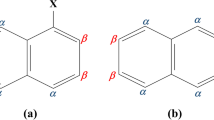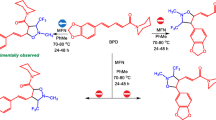Abstract
The complexes of B3O3H3 with acetylene and its substituted derivatives C2HX (X=H, F, Cl, Br, CH3, NH2) are explored by theoretical calculations using MP2 and M06-2X methods with aug-cc-pVDZ as the basis set. The different molecular electrostatic potential features of B3O3H3 with benzene (C6H6) and borazine (B3N3H6) result in different stable structures of the complexes with C2HX. The geometric analysis indicates that the global minimum is the parallel stacked (PS) structure with the linear C–C triple bond lies on the top of B3O3H3, and this is much different from that of the B3N3H6...C2HX complex, in which the C–H bond directs towards the B3N3H6 ring (T-shaped). The H-bonded structure where the C–H interacts with the O atom of B3O3H3 is found to be a local minimum. Besides, there is an additional X…O halogen-bonded structures for the B3O3H3…C2HX (X=Cl, Br) complexes. As for the PS geometry, when one H atom in C2H2 is replaced by different X groups, the binding energies of the complexes increases in the order of F<H<Cl<Br<CH3<NH2, which is mainly determined by the strength of the π-hole bond. The nature of interaction in these complexes is further studied by the atoms-in-molecules (AIM) and noncovalent interaction (NCI) analysis. The natural bond orbital (NBO) analysis indicates that the main orbital interaction arises from LPX→BD*B‑O for B3O3H3…C2HX (X=Cl, Br, NH2), and BDC‑C→BD*B‑O for B3O3H3…C2HX (X=H, CH3) complexes.

Complexes of B3O3H3 with acetylene and its substituted derivatives.





Similar content being viewed by others
References
Steudel R (1992) The chemistry of inorganic ring systems. Elsevier, New York
Costa A, Costa ER, Silva ALP, Tanaka AA, Varela JDG (2018) Theoretical study of the effects of substituents (F, Cl, Br, CH3, and CN) on the aromaticity of borazine. J Mol Model 24(1):11. https://doi.org/10.1007/s00894-017-3555-x
Deshmukh V, Nagnathappa M, Kharat B, Chaudhari A (2014) Theoretical study of borazine and substituted borazines using density functional theory method. J Mol Liq 193:13–22. https://doi.org/10.1016/j.molliq.2013.12.011
Kiran B, Phukan AK, Jemmis ED (2001) Is borazine aromatic? Unusual parallel behavior between hydrocarbons and corresponding B-N analogues. Inorg Chem 40(14):3615–3618. https://doi.org/10.1021/ic001394y
Kaldor A, Pines I, Porter RF (1969) Reactivity of boroxine. Reactions with azomethane and azoethane. Inorg Chem 8(7):1418–1423. https://doi.org/10.1021/ic50077a010
Kalemos A (2018) The nature of the chemical bond in borazine (B3N3H6), boroxine (B3O3H3), carborazine (B2N2C2H6), and related species. Int J Quantum Chem 118(16):e25650. https://doi.org/10.1002/qua.25650
Fowler PW, Steiner E (1997) Ring currents and aromaticity of monocyclic pi-electron systems C6H6, B3N3H6, B3O3H3, C3N3H3, C5H5 −, C7H7 +, C3N3F3, C6H3F3, and C6F6. J Phys Chem A 101(7):1409–1413. https://doi.org/10.1021/jp9637946
Tossell JA, Lazzeretti P (1990) Calculation of the structure, vibrational-spectra, and polarizability of boroxine, H3B3O3, a model for boroxol rings in vitreous B2O3. J Phys Chem 94(5):1723–1724. https://doi.org/10.1021/j100368a004
Korich AL, Iovine PM (2010) Boroxine chemistry and applications: a perspective. Dalton Trans 39(6):1423–1431. https://doi.org/10.1039/b917043j
Wason SK, Porter RF (1964) Gaseous boroxine: infrared spectrum and structure. J Phys Chem 68(6):1443–1447. https://doi.org/10.1021/j100788a029
Chang CH, Porter RF, Bauer SH (1969) Molecular structure of boroxine, H3B3O3, determined by electron diffraction. Inorg Chem 8(8):1689–1693. https://doi.org/10.1021/ic50078a024
Miyaura N, Suzuki A (1995) Palladium-catalyzed cross-coupling reactions of organoboron compounds. Chem Rev 95(7):2457–2483. https://doi.org/10.1021/cr00039a007
Alcaraz G, Euzenat L, Mongin O, Katan C, Ledoux I, Zyss J, Blanchard-Desce M, Vaultier M (2003) Improved transparency–nonlinearity trade-off with boroxine-based octupolar molecules. Chem Commun 22:2766–2767. https://doi.org/10.1039/B308664J
Li DZ, Zhang SG, Liu JJ, Tang C (2014) Vanadium sandwich complexes with boroxine and boronyl boroxine ligands. Eur J Inorg Chem 21:3406–3410. https://doi.org/10.1002/ejic.201402258
Sarmah N, Bhattacharyya PK, Bania KK (2014) Substituent and solvent effects on the absorption spectra of cation-pi complexes of benzene and borazine: a theoretical study. J Phys Chem A 118(21):3760–3774. https://doi.org/10.1021/jp5021966
Zhuo HY, Li QZ, Li WZ, Cheng JB (2014) Is pi halogen bonding or lone pair center dot center dot center dot pi interaction formed between borazine and some halogenated compounds? Phys Chem Chem Phys 16(1):159–165. https://doi.org/10.1039/c3cp54006e
Bagheri S, Masoodi HR (2015) Theoretical study of the influence of cation-π and anion-π interactions on some NMR data of borazine complexes. Chem Phys Lett 629:46–52. https://doi.org/10.1016/j.cplett.2015.04.017
Lisovenko AS, Timoshkin AY (2015) Complexes of borazine and its analogs with Lewis acids and bases. Russ Chem B+ 64(11):2573–2585. https://doi.org/10.1007/s11172-015-1192-z
Khanh PN, Ngan VT, Man NTH, Nhung NTA, Chandra AK, Trung NT (2016) An insight into Csp-H...π hydrogen bonds and stability of complexes formed by acetylene and its substituted derivatives with benzene and borazine. RSC Adv 6(108):106662–106670. https://doi.org/10.1039/c6ra21557b
Mishra P, Verma K, Bawari D, Viswanathan KS (2016) Does borazine-water behave like benzene-water? A matrix isolation infrared and ab initio study. J Chem Phys 144(23):9. https://doi.org/10.1063/1.4953793
Bauza A, Quinonero D, Deya PM, Frontera A (2012) Theoretical ab initio study of anion-π interactions in inorganic rings. Chem Phys Lett 530:145–150. https://doi.org/10.1016/j.cplett.2012.01.079
Zhuo HY, Li QZ, Li WZ, Cheng JB (2014) Is π halogen bonding or lone pair...π interaction formed between borazine and some halogenated compounds? Phys Chem Chem Phys 16(1):159–165. https://doi.org/10.1039/c3cp54006e
Verma K, Viswanathan KS, Majumder M, Sathyamurthy N (2017) How different is the borazine-acetylene dimer from the benzene-acetylene dimer? A matrix isolation infrared and ab initio quantum chemical study. Mol Phys 115(21–22):2637–2648. https://doi.org/10.1080/00268976.2017.1284357
Frisch MJ, Trucks GW, Schlegel HB, Scuseria GE, Robb MA, Cheeseman JR, Scalmani G, Barone V, Petersson GA, Nakatsuji H, Li X, Caricato M, Marenich AV, Bloino J, Janesko BG, Gomperts R, Mennucci B, Hratchian HP, Ortiz JV, Izmaylov AF, Sonnenberg JL, Williams DF, Lipparini F, Egidi F, Goings J, Peng B, Petrone A, Henderson T, Ranasinghe D, Zakrzewski VG, Gao J, Rega N, Zheng G, Liang W, Hada M, Ehara M, Toyota K, Fukuda R, Hasegawa J, Ishida M, Nakajima T, Honda Y, Kitao O, Nakai H, Vreven T, Throssell K, Montgomery Jr JA, Peralta JE, Ogliaro F, Bearpark MJ, Heyd JJ, Brothers EN, Kudin KN, Staroverov VN, Keith TA, Kobayashi R, Normand J, Raghavachari K, Rendell AP, Burant JC, Iyengar SS, Tomasi J, Cossi M, Millam JM, Klene M, Adamo C, Cammi R, Ochterski JW, Martin RL, Morokuma K, Farkas O, Foresman JB, Fox DJ (2016) Gaussian 16 revision. A.03. Gaussian Inc., Wallingford
Boys SF, Bernardi F (1970) Calculation of small molecular interactions by differences of separate total energies - some procedures with reduced errors. Mol Phys 19(4):553–566. https://doi.org/10.1080/00268977000101561
Burns LA, Marshall MS, Sherrill CD (2014) Comparing counterpoise-corrected, uncorrected, and averaged binding energies for benchmarking noncovalent interactions. J Chem Therory Comput 10(1):49–57. https://doi.org/10.1021/ct400149j
Bulat FA, Toro-Labbe A, Brinck T, Murray JS, Politzer P (2010) Quantitative analysis of molecular surfaces: areas, volumes, electrostatic potentials and average local ionization energies. J Mol Model 16(11):1679–1691. https://doi.org/10.1007/s00894-010-0692-x
Lu T, Chen FW (2012) Multiwfn: a multifunctional wavefunction analyzer. J Comput Chem 33(5):580–592. https://doi.org/10.1002/jcc.22885
Humphrey W, Dalke A, Schulten K (1996) VMD: Visual molecular dynamics. J Mol Graph Model 14(1):33–38. https://doi.org/10.1016/0263-7855(96)00018-5
Glendening ED, Reed AE, Carpenter JE, Weinhold F NBO Version 3.1
Wang H, Wang W, Jin WJ (2016) σ-Hole bond vs π-hole bond: a comparison based on halogen bond. Chem Rev 116(9):5072–5104. https://doi.org/10.1021/acs.chemrev.5b00527
Thi Hong Man N, Le Nhan P, Vo V, Tuan Quang D, Tien Trung N (2017) An insight into C□H···N hydrogen bond and stability of the complexes formed by trihalomethanes with ammonia and its monohalogenated derivatives. Int J Quantum Chem 117(6):e25338. https://doi.org/10.1002/qua.25338
Mishra BK, Karthikeyan S, Ramanathan V (2012) Tuning the C-H...pi interaction by different substitutions in benzene-acetylene complexes. J Chem Therory Comput 8(6):1935–1942. https://doi.org/10.1021/ct300100h
Shibasaki K, Fujii A, Mikami N, Tsuzuki S (2007) Magnitude and nature of interactions in benzene-X (X = ethylene and acetylene) in the gas phase: significantly different CH/pi interaction of acetylene as compared with those of ethylene and methane. J Phys Chem A 111(5):753–758. https://doi.org/10.1021/jp065076h
Bader RFW (2000) Atoms in molecules. A Quantum Theory. Clarendon Press, Oxford
Bader RFW (1991) A quantum theory of molecular structure and its applications. Chem Rev 91(5):893–928. https://doi.org/10.1021/cr00005a013
Arnold WD, Oldfield E (2000) The chemical nature of hydrogen bonding in proteins via NMR: J-couplings, chemical shifts, and AIM theory. J Am Chem Soc 122(51):12835–12841. https://doi.org/10.1021/ja0025705
Koch U, Popelier PLA (1995) Characterization of C-H...O hydrogen-bonds on the basis of the charge density. J Phys Chem 99(24):9747–9754. https://doi.org/10.1021/j100024a016
Lipkowski P, Grabowski SJ, Robinson TL, Leszczynski J (2004) Properties of the C-H...H dihydrogen bond: an ab initio and topological analysis. J Phys Chem A 108(49):10865–10872. https://doi.org/10.1021/jp048562i
Hassan A, Dinadayalane TC, Grabowski SJ, Leszczynski J (2013) Structural, energetic, spectroscopic and QTAIM analyses of cation-π interactions involving mono- and bi-cyclic ring fused benzene systems. Phys Chem Chem Phys 15(48):20839–20856. https://doi.org/10.1039/C3CP53927J
Espinosa E, Molins E, Lecomte C (1998) Hydrogen bond strengths revealed by topological analyses of experimentally observed electron densities. Chem Phys Lett 285(3):170–173. https://doi.org/10.1016/S0009-2614(98)00036-0
Johnson ER, Keinan S, Mori-Sanchez P, Contreras-Garcia J, Cohen AJ, Yang WT (2010) Revealing noncovalent interactions. J Am Chem Soc 132(18):6498–6506. https://doi.org/10.1021/ja100936w
Wu Q, Su H, Wang H, Wang H (2018) Ab initio calculations, structure, NBO and NCI analyses of XH⋯π interactions. Chem Phys Lett 693:202–209. https://doi.org/10.1016/j.cplett.2018.01.015
Michalczyk M, Zierkiewicz W, Scheiner S (2018) Triel-bonded complexes between TrR3 (Tr=B, Al, Ga; R=H, F, cl, Br, CH3) and Pyrazine. ChemPhysChem 19(22):3122–3133. https://doi.org/10.1002/cphc.201800774
Zhang L, Li D (2019) An insight into intramolecular blue-shifting CH⋯π hydrogen bonds in 1,3-hexadien-5-yne and its halogen-substituted derivatives. Chem Phys 518:58–68. https://doi.org/10.1016/j.chemphys.2018.11.001
Alabugin IV, Manoharan M, Peabody S, Weinhold F (2003) Electronic basis of improper hydrogen bonding: a subtle balance of hyperconjugation and rehybridization. J Am Chem Soc 125(19):5973–5987. https://doi.org/10.1021/Ja034656e
Mukhopadhyay A, Pandey P, Chakraborty T (2010) Blue- and Red-Shifting CH...O Hydrogen Bonded Complexes between Haloforms and Ethers: Correlation of Donor ν(C-H) Spectral Shifts with C-O-C Angular Strain of the Acceptors. J Phys Chem A 114(14):5026–5033. https://doi.org/10.1021/Jp100524q
Acknowledgements
This work was supported by the Natural Science Foundation of Shandong Province under Grant No. ZR2017MB023 and No. ZR2016BL09 and the Research Fund of Binzhou University under Grant No. BZXYLG1919.
Author information
Authors and Affiliations
Corresponding author
Additional information
Publisher’s note
Springer Nature remains neutral with regard to jurisdictional claims in published maps and institutional affiliations.
Rights and permissions
About this article
Cite this article
Zhang, L., Li, D. A theoretical investigation on the complexes of B3O3H3 with acetylene and its substituted derivatives. J Mol Model 25, 332 (2019). https://doi.org/10.1007/s00894-019-4223-0
Received:
Accepted:
Published:
DOI: https://doi.org/10.1007/s00894-019-4223-0




